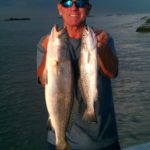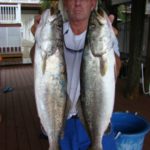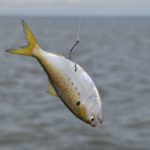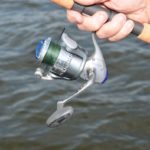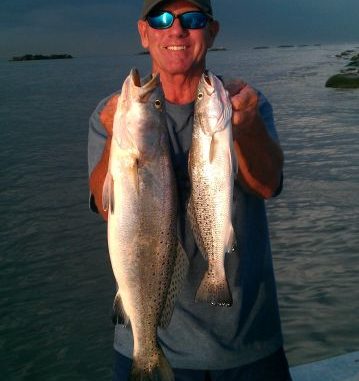
Capt. Steve Shook has been known for decades for catching huge trout, and he’s now sharing the secrets to his success.
Speckled trout have always been the premier gamefish in Louisiana’s coastal marshes, and big speckled trout — the kind that are 7 pounds and larger — are the stuff of which dreams are made.
In the late 1970s word began to leak out of south Lafourche Parish about a guy who was free-lining live pogies into the rocks armoring South Timbalier Island and catching big speckled trout — really, really big trout.
And he was secretive, almost obsessively secretive.
It was Steve Shook.
Louisiana has long produced noted big-speckled trout fishermen, but Shook was arguably the first modern trophy trout angler. But his competitive nature soon diverted much of his attention to fishing the big-money circuit for king mackerel and, as other trophy trout fishermen sharpened their skills, Shook’s name receded into the background.
Now he is back. He is still chasing big speckled trout. He is still free-lining pogies. And most important, the now more-easy-going Steve Shook is willing to share some of his secrets.
Using pogies to catch speckled trout takes three separate skills, according to the expert: Finding and catching the baitfish, holding and handling them, and fishing with them.
Following are his thoughts on each of these aspects of the technique.
Finding and catching pogies
Steve Shook catches pogies mainly in two places: dead-end canals and bay openings.
Dead-end canals are productive very early in the morning — as early as there is any visibility — because pogies use the canals at night but leave with daylight.
Schools of pogies can be seen as faint ripples on the calm water’s surface.
Bay openings are his bread and butter, though.
“Pogies like current,” Shook explained.
He looks for places where tide-driven water current from a bayou spills into an open bay.
At the bayou’s mouth, he shuts his boat motor off and drifts with the current, intently studying the water close by and in the far distance.
What he looks for are telltale scattered flicks on the water’s surface. A few flicks can mean a lot more pogies beneath the surface.
He also scans the distance for diving pelicans; the more birds, the better.
When Shook finds pogies in a spot, he will return to it over and over again to catch bait.
Absolute silence is critical, he cautioned. Trolling motor noise can spook pogies. He even shuts off the pump on his livewell. The steady flicking of a school of pogies in the distance will instantly disappear with a touch of the ignition key for the boat’s motor.
Another important tactic, whenever possible, is to drift with the sun in the angler’s face. With this position, the fisherman’s body casts no shadow ahead of the boat.
Shook throws a 10-foot diameter, 5/8-inch (1 ¼-inches stretched) cast net. But a smaller net is easier for beginners to throw, he said.
“You can catch pogies with an 8-foot net, and anything from ¼-inch to 1 ½-inch (½ inches to 3 inches stretched) mesh size is fine,” Shook said.
A cast net pan can be helpful for some people, Shook added a little reluctantly. He uses a heavy duty fiberglass pan that he makes for himself. His hesitation in recommending the pan is that it takes great arm strength to use it to cast the large net he uses.
Holding and handling pogies
A good livewell is critical for holding pogies, which are a relatively fragile bait.
Shook has used a Kodiac Pro Flo livewell since the 1970s.
His favorite setup is a 27-gallon oval tank with a 2000 series pump. He likes the larger pump rather than the smaller 1500 series pump; with this tank and pump, he can hold up to 200 4- to 5-inch pogies.
If the larger pump creates too much flow, he cautioned, it will wash the slime off of the bait and they will get what he calls “clown nose,” a red nose that is a sign of stress. Water flow can be reduced by regulating the pump’s valve.
Shook stressed the importance of not crowding the livewell.
“If I catch 300 pogies, I turn 100 of them loose,” he said. “If you put too many in the tank, the ammonia will kill them.
“More is not better with pogies.”
Shook also is quick to change the water in his livewell.
“If I catch bait early in the morning, when I get to my first fishing spot I will drain the well and pump it up with fresh water,” he said.
Free-lining with pogies
Steve Shook likes to hook his pogies through the belly near the anus. “Hooking them in the butt,” is what he calls it.
“Some people like to hook pogies through the eye sockets or nostrils,” Shook said. “Hooking them (through the belly) creates a flutter swim from the bait. Also, the trout don’t feel the hook as easily when they take the bait.
“One more thing is that a pogie hooked in the butt casts better. It actually ‘swims’ in the air and doesn’t splat when it hits the water. It can swim down immediately, so birds are less likely to attack it.”
Shook almost exclusively uses spinning reels, feeling he can get the best performance from them in casting free-lined baits. He favors Quantum Cabo 40 reels and 7-foot, 6-inch medium-action Quantum Boca rods.
“I’ve never broken one of these rods,” he explained, “and with all the cork in the handle, they will float if dropped overboard.”
The rest of his rig is light — surprisingly so, considering the size of the trout that he catches.
“From the get-go, I liked fishing light — hooking meat; no hardware,” he grinned.
He spools his reels with 20-pound braided line to which he attaches a 2- to 2 ½-foot 20-pound-test green monofilament Trilene leader with a surgeon’s knot. The hook is attached to the leader with a simple improved clinch knot.
His hooks are small: 1/0 kahles.
“I don’t want fish to feel hardware in their mouths,” Shook explained.
He uses no sinker, no swivel, no cork. He casts the pogie to where he wants it to be and feeds line to it from the open bail of his reel as the fish moves.
He explained that the size of the pogie determines how he fishes them.
“Bait size matters,” Shook said. “There is an art to catching trout on big pogies 6 inches and bigger. The best thing for the average person to do is leave the rod in a holder. The average fisherman strikes too quickly and too hard.
“I will flip the bail open on my spinning reel and feed the fish four or five strokes of line after it takes the bait. Then I will flip the bait shut and strike.”
Smaller pogies call for an altoghether different approach.
“With smaller pogies, 3 inches or so, I pick the rod tip up on a hit and just begin reeling. Never set the hook!” Shook said. “Most people get too aggressive when they have a big fish on the hook. Keep your rod tip up and calm down.”
Finally, when you fish with Shook, you learn never to strip an old bait off the hook and toss it into the water.
“It don’t take but one or two of those baits and a trout is full,” the veteran angler said.
He ended with a tip.
“Tell your readers that in April they need to fish the beaches of Fourchon, Penrod Pass, Elmer’s Island, the (sunken) barges (of rocks) at Fourchon and the rocks of Bell Pass,” Shook said. “East and West Timbalier usually come in May.
“My favorites there are the rocks at East Timbalier, and the beaches and sunken barge at West Timbalier.”
